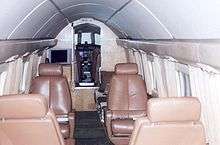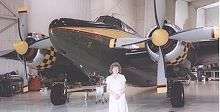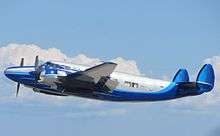Howard 500
The Howard 500 is an American executive transport aircraft produced by Howard Aero Inc during the early 1960s.
| Howard 500 | |
|---|---|
 | |
| Howard 500 N500LN demonstrating at Coventry airport, UK, in August 2000 | |
| Role | Executive aircraft |
| National origin | United States |
| Manufacturer | Howard Aero Inc |
| Designer | Dee Howard [n 1] and Ed Swearingen |
| First flight | September 1959 |
| Number built | 22 |
Design and development
During the 1950s and '60s, Howard Aero Inc. had been remanufacturing military surplus Lockheed Lodestars and Lockheed Venturas for the executive market.
While the Howard 500 bore a strong resemblance to these aircraft, it was a substantially new design, and all 500s had completely new fuselages. The only major components taken directly from its Lockheed forebears were the outer wing panels (from surplus Venturas) and undercarriage (from PV-2 Harpoons). Howard purchased wing and fuselage jigs from Lockheed to use as patterns for jigs for the new aircraft. The fuselage differed from the Ventura's in being designed from the outset for pressurisation, and the wings were designed wet. The pressurisation system maintained a differential of 46.5 kilopascals (6.75 psi) which was greater than any other prop or turboprop executive aircraft on the market at the time and maintained a sea level cabin pressure at up to 16,000 feet (4,900 m).[1]
The engine chosen was a new, higher-power and lighter-weight version of the Pratt & Whitney R-2800 that had been developed for the Douglas DC-6. Propeller hubs were taken from F4U Corsairs, four-blade propellers and spinners from DC-7s.

The Howard 500 could accommodate 10 to 14 passengers with a large window for each. Increased fuel tankage over the PV-2 Ventura gave a maximum range with full reserves of 2,600 miles (4,200 km). Maximum cruising speed was 350 mph (300 kn; 560 km/h) at 21,000 feet (6,400 m). This exceptional performance for a piston engined executive aircraft unfortunately came just as the competing turboprop designs were coming to the market, and this restricted sales of the type.
The prototype flew in September 1959,[2] and certification was achieved on February 20, 1963.[2] By this time, however, the executive market was already dominated by turboprop aircraft, and although its performance was comparable to (or even better than) these new machines, and its price substantially lower, the Howard 500 could not effectively penetrate the market.
Twenty-two Howard 500s were produced initially, with a further eight being converted from earlier PV-2s to virtually the same standard.[3]
Operators
Commercial firms operating the aircraft included: Republic Steel, Green Construction of Indiana, KF Airlines, Pacific Petroleum of Canada, Northern Natural Gas Company and U.S. Metal Refining Company.[4]
Surviving aircraft


Of the 17 examples built to full Howard 500 standard, two restored aircraft remain flying.
The first example is in the United States (construction number 500-105, registration N500HP) which was initially operated by the Natural Gas Pipeline Company of America, and later by the Phillippi Equipment Company. As of 2015 it is based at Anoka County Airport near Minneapolis in Minnesota, and was awarded Grand Champion at EAA AirVenture Oshkosh in 1997.
The second, N500LN was restored in the UK and left Exeter (EGTE) on 18 May 2010 at 14:42 UTC. The aircraft departed to Coventry airport. The aircraft's last flight prior to this was on 14 August 2000, since then it had been in storage / restoration at Exeter until its departure to Coventry. N500LN was originally registered N539N built in 1962, construction number 500-113. This aircraft was purchased by the tpaero group in October 2009. During 2011 and 2012 it was based in Austria. In July 2013 it performed demonstration flights at the EAA convention at Oshkosh Wisconsin. It is based at the Anoka County Airport in the US state of Minnesota.
Specifications
Data from Jane's All The World's Aircraft 1965-66 [2]
General characteristics
- Crew: 2
- Capacity: 10–14 passengers
- Length: 58 ft 5 1⁄2 in (17.818 m)
- Wingspan: 70 ft 4 in (21.44 m)
- Height: 13 ft 7 in (4.14 m)
- Wing area: 592.22 sq ft (55.019 m2)
- Aspect ratio: 8.35:1
- Empty weight: 23,000 lb (10,433 kg)
- Max takeoff weight: 35,000 lb (15,876 kg)
- Fuel capacity: 1,550 US gal (1,290 imp gal; 5,900 L)
- Powerplant: 2 × Pratt & Whitney R-2800-CB17 eighteen-cylinder two-row radial engines, 2,500 hp (1,900 kW) each
- Propellers: 4-bladed Hamilton-Standard 24E60-7037A-50 propellers
Performance
- Maximum speed: 410 mph (660 km/h, 360 kn) at sea level
- Cruise speed: 350 mph (560 km/h, 300 kn) at 21,000 ft (6,400 m) (econ.cruise)
- Stall speed: 103 mph (166 km/h, 90 kn)
- Never exceed speed: 450 mph (720 km/h, 390 kn)
- Range: 2,600 mi (4,200 km, 2,300 nmi)
- Service ceiling: 35,000 ft (11,000 m)
- Rate of climb: 2,550 ft/min (13.0 m/s)
- Takeoff distance to 50 ft (15 m): 2,412 ft (735 m)
- Landing distance from 50 ft (15 m): 3,575 ft (1,090 m)
Footnotes
- Dee Howard is not related to Benny Howard, racing pilot and aircraft designer of the Howard DGA aircraft series of two decades earlier.
References
Notes
- Marson, 2001, p. 26
- Taylor 1965, pp. 243–244.
- Marson, 2001, p. 27
- Marson, 2001
Bibliography
- Marson, Peter (2001). Lockheed Twins. Air-Britain (Historians) Ltd. ISBN 0-85130-284-X.
- Taylor, John W. R. (1965). Jane's All the World's Aircraft 1965-66. London: Sampson Low, Marston.
- Taylor, Michael J. H. (1989). Jane's Encyclopedia of Aviation. London: Studio Editions. p. 511.
External links
| Wikimedia Commons has media related to Howard 500. |
- N500HP web site
- Howard 500 on Lockheed Twins site
- The Howard 500 Project - Development of Howard 500 model for Microsoft Flight Simulator, with extensive detail, photographs, and movies of real aircraft.
- Rare Vintage Bizliner Hits The Market